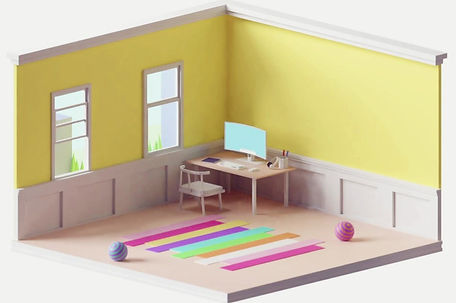Frequently Asked Questions
Teletherapy, also referred to as telehealth, is an online video therapy service. Using a HIPAA-safe video conference system, therapy services are delivered directly to your child via the internet.
Similar to an online conference or college course we meet in a virtual space in real-time and talk, educate and interact to achieve a common goal. In pediatric therapy we strive towards skills development and goal acquisition guided by an established plan of care for your child.
Research has proven that teletherapy is as effective as in-person therapy for treating pediatric therapy needs. Some benefits of teletherapy are:
Helps reduce missed visits due to illness and prevents the spread of illness
Families who live in rural areas have access to more providers
Families may have access to more specialized providers
Just like an in-home therapy session, the focus of Teletherapy is on the family’s needs and goals
In Teletherapy sessions, the caregiver takes a more active role in the therapy session, focusing on caregiver-child interactions
Teletherapy is a proven method to meet a child’s goals
Very safe! Our therapy platform meets and exceeds the legally required HIPAA, FERPA, and COPPA standards of service to protect your child’s confidentiality.
Set-Up is Easy! We recommend the following:
Quiet space with good lighting is essential.
Computer, laptop, or a tablet with a keyboard and mouse or trackpad.
Internal or external webcam, microphone and speaker, or a headset with a microphone.
Selection of common household items to use as therapy tools during our sessions. We will provide a list of what you'll need.
No, prior to the appointment, your therapist will send you a private link to access the session. Just click the link and you’ll be ready to join the session!
You can also join through your client portal which can be accessed in the top right hand corner of the PRISM website.
Please do not purchase anything prior to starting your therapy. Your first few sessions will include family conversations regarding “teletherapy orientation”.
We will discuss what your sessions will be like, consist of, and materials needed. Then, your therapist will discuss how to utilize common household items and play-things to maximize growth and progress.
Access our calendar and schedule appointments by clicking on the grey "Client Log-In" button located in the upper right corner of the Prism website homepage.
Our "Open Calendar" system is easy to navigate. Simply scan for the days and dates that fit your schedule, and click on a spot to reserve it. In conjunction with your child's recommended plan of care, you may book a single session, a week's worth of therapy, or even schedule a month or two at a time.
Typically teletherapy sessions last 45 minutes, but are dependent on your child’s needs.
Prior to the session, the therapist may send you a short “lesson plan” and list of items/ toys suggested for the session activities.
In general, for an infant or toddler, our therapist will demonstrate new activities or techniques and coach the parent through them. For a preschooler, plan to sit next to your child on the floor or at the table and work together closely with the therapist. School age children, depending on their goals, may be able to work independently through the session. However, the parent should remain nearby for assistance.
The therapist is able to share her screen, play games, share handouts, resources and more throughout the session.
At the end of the session, the therapist will discuss how to continue the session activities throughout the week, any concerns you may have, and schedule the next visit.
We require that you have a learning coach present for your child’s sessions. This can include a parent, older sibling, babysitter/nanny, etc. Although they may not need to sit beside your child for the entire session, it is helpful to have a facilitator on hand. Your participation will also be essential for parent education and home program development.
To make the most of your therapy session, be willing to learn new techniques, ask questions, give feedback to your therapist, voice your concerns, look for activities and strategies that you can do to help your child, and practice the activities you did during the teletherapy session.
Your therapist will provide ideas and strategies to make teletherapy sessions as productive as possible. Just as in in-person sessions, a certain amount of non-cooperation is to be expected. When children are challenged it’s not untypical for them to act out with certain behaviors.

.png)